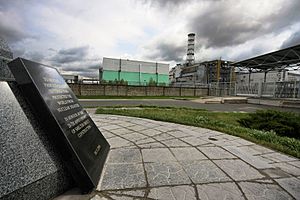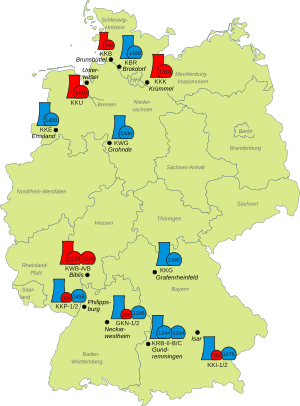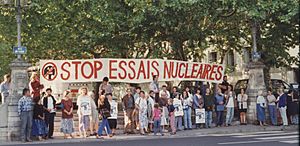Nuclear energy policy facts for kids
Nuclear energy policy is all about the rules and decisions countries make about using nuclear energy. This includes everything from digging up nuclear fuel to making electricity in nuclear power plants, and even how they handle the used fuel.
Because nuclear energy technology is similar to that used for nuclear weapons, decisions about energy can also be linked to military goals. Also, the worry about more countries getting nuclear weapons affects how countries make their nuclear energy rules.
Not many countries use nuclear energy. In 2007, only 31 out of 191 United Nations countries had nuclear power plants. Countries that relied most on nuclear energy included France (75% of its electricity from nuclear power), Lithuania, Belgium, Bulgaria, Slovakia, Sweden, Ukraine, and South Korea. The USA made the most nuclear power (28% of the world's total), followed by France (18%) and Japan (12%). By 2000, there were 438 nuclear power units around the world.
After the Fukushima nuclear disaster in Japan in March 2011, some countries changed their minds about nuclear power. Germany shut down eight of its 17 reactors. Italy decided not to use nuclear power. Switzerland and Spain stopped building new reactors. As of 2013, many countries like Australia, Austria, Denmark, Greece, Ireland, Italy, Latvia, Lichtenstein, Luxembourg, Malta, Portugal, Israel, Malaysia, New Zealand, and Norway were still against it. Germany and Switzerland are slowly stopping their use of nuclear power. In recent years, more nuclear power plants have closed than opened worldwide.
Contents
How Do Countries Decide on Nuclear Energy?
After the 2011 accident at the Fukushima Daiichi Nuclear Power Plant in Japan, many countries like China, Germany, Switzerland, and the United Kingdom started looking closely at their nuclear power plans again. Some countries, such as Indonesia and Vietnam, still plan to build new nuclear power plants. Other countries, like Australia, Austria, and New Zealand, are still against using nuclear power.
Nuclear Energy in Australia
Australia does not produce any nuclear power. Plans to consider building nuclear power plants were stopped in 2007 when Kevin Rudd, who was against nuclear power, became prime minister.
Nuclear Energy in Finland
As of 2006, Finland had four nuclear reactors. The first one started working in 1977. These reactors now provide 27% of Finland's electricity.
A new reactor called Olkiluoto 3 was planned to start in 2011. It was designed to produce a lot of power. However, its construction began in August 2005 and faced many problems. Two and a half years later, it was "over two years behind schedule and at least 50% over budget." This caused big losses for the company building it.
Nuclear Energy in France
After an oil crisis in the early 1970s, France decided in 1974 to become more independent in making its own electricity. They did this mainly by building many nuclear power stations. Today, France gets about 78.1% of its electricity from nuclear power.
Because France makes more electricity than it needs, it sells some of its nuclear-produced energy to other countries. This includes countries like Germany, which are officially against using nuclear energy themselves. A new large reactor is being built in Flamanville, Normandy, and is expected to be finished in 2012.
In the 1970s, a movement against nuclear power grew in France. There were many large protests. More recently, groups like Greenpeace have continued to campaign.
Nuclear Energy in Germany

In 2000, the German government announced it would slowly stop using nuclear power. They made an agreement with energy companies to shut down the country's nineteen nuclear power plants by 2020. This plan became a law called the Nuclear Exit Law. Some plants were turned off in 2003 and 2005.
However, the law did not stop all nuclear activities. There were worries about how safe it would be to transport nuclear waste. In 2005, Angela Merkel became the leader of Germany. She wanted to talk about changing the deadline for shutting down the power stations. But for now, the plan to stop using nuclear power has stayed in place.
In November 2008, a shipment of radioactive waste from German nuclear plants arrived at a storage site. It was delayed by large protests from people against nuclear power. More than 15,000 people blocked trucks and roads. These protests were partly because some politicians wanted to rethink the plan to stop using nuclear power.
Nuclear Energy in Japan
Japan has 55 nuclear reactors that produce about 30% of its total electricity. There are plans to increase this to 37% by 2009 and 41% by 2014.
On July 16, 2007, a strong earthquake hit the area where the Kashiwazaki-Kariwa Nuclear Power Plant is located. This plant is the largest single nuclear power station in the world. All its reactors were shut down and stayed closed for at least a year for checks and repairs.
During the Fukushima nuclear disaster on March 11, 2011, the cooling systems at the Fukushima Daiichi Nuclear Power Plant failed. This was the first time Japan declared a nuclear emergency. About 140,000 people living near the plant had to move away. Explosions and a fire caused dangerous levels of radiation. This led to problems in the stock market and people buying too much food in supermarkets because they were worried.
Nuclear Energy in the United States
The Shippingport power plant was the first commercial nuclear power plant built in the United States in 1958. In the 1960s, it was thought that over 1,000 reactors would be working in the US by 2000. However, by the end of the 1970s, it was clear this would not happen, and more than 120 reactor orders were cancelled.
As of 2007, the United States has 104 commercial nuclear power units. They produce about 20% of the country's total electricity. The United States is the world's largest producer of commercial nuclear power.
The Three Mile Island accident was the most serious accident in the US nuclear industry. Other incidents include those at the Davis-Besse Nuclear Power Plant.
Several US nuclear power plants closed earlier than planned. For example, Rancho Seco closed in 1989, and Zion Nuclear Power Station closed in 1998. The Humboldt Bay Nuclear Power Plant closed in 1976 because it was built on a fault line. The Shoreham Nuclear Power Plant never even started working commercially because a safety plan could not be agreed upon after the Three Mile Island and Chernobyl accidents.
Many plants have recently been allowed to operate for another 20 years.
Images for kids
-
The number of nuclear power plant constructions started each year, from 1954 to 2013. Notice the increase from 2007 to 2010, before a drop after the 2011 Fukushima Daiichi nuclear disaster.
See also
 In Spanish: Política sobre energía nuclear para niños
In Spanish: Política sobre energía nuclear para niños






